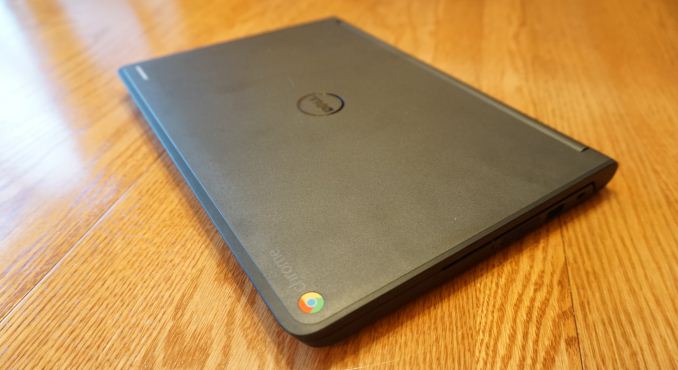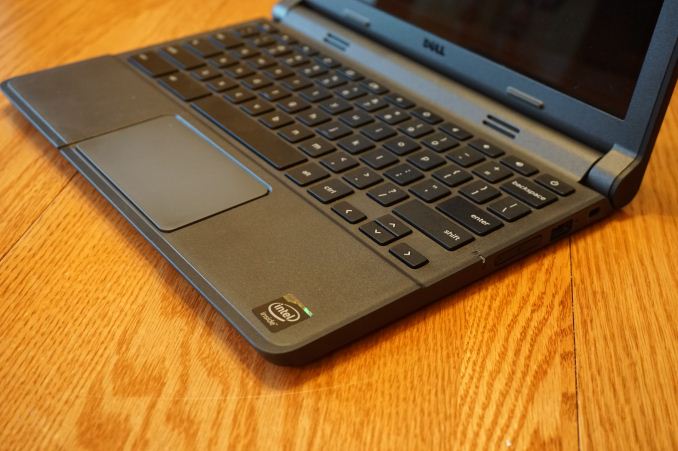The Dell Chromebook 11 Touch Review
by Brandon Chester on May 7, 2015 8:00 AM EST- Posted in
- Laptops
- Chrome OS
- Chromebook
Final Words
As far as Chromebooks go, I think the Dell Chromebook 11 is one of the better devices you can buy without spending $1000 on a Chromebook Pixel. While Intel's Celeron N2840 is more like an Atom chip, it's still perfectly sufficient for the tasks that users will perform on a Chromebook. You can certainly drop even lower in price, with Chromebooks available for $149 and even $99, but you end up making even more hardware sacrifices which significantly compromise the user experience.
Dell has definitely accomplished what they set out to do with the Dell Chromebook 11. It's more than fast enough to run Chrome OS, has an ample amount of RAM to keep your tabs open, and it has the best web browsing battery life of all the Chromebooks and tablets that we've ever tested. It's also very durable and well constructed. While the design isn't exactly stunning, it avoids looking like a bulky brick laptop that you would bring to use in a war zone.
Unfortunately, the Dell Chromebook 11 with the touchscreen faces some serious competition from Toshiba's Chromebook 2. Both of them have roughly the same internal specifications, but the Toshiba has a display that is vastly superior in every respect, without the not very useful touchscreen capabilities. Dell's pursuit of a touchscreen and a highly durable design have forced them to cut costs with the display quality in order to reach their price of $329. For your average user, I really have to give the Toshiba the recommendation over the Dell Chromebook 11 at that price point, as the higher resolution display makes everything sharper and allows much more to be seen on screen than a cramped 1366x768 display. While the Toshiba's battery life is significantly shorter due to the increased display power usage, I still think it's the better option.
Despite my feeling that the Toshiba Chromebook 2 is a better purchase for most users, the Dell Chromebook 11 doesn't lack appeal to certain segments of the market. One of the markets that I believe it will be widely adopted in will be education. While I feared that schools and other academic institutions would simply opt for the most inexpensive Chromebooks possible for budget related reasons, some investigation of the local high school in my area revealed that they already have a large number of Dell Chromebook 11 units in use. Some students don't tend to take care of electronic devices that don't belong to them, and the Dell Chromebook 11 stands up to the abuse and misuse better than other devices.
The other area where the Dell Chromebook 11 will stand above the Toshiba is any environment that isn't electronics friendly. People working in construction or in geographical areas where dust and dirt are unavoidable will definitely benefit from the rugged design and MIL-STD rated resistance to fluids, dust, etc.
There is one final consideration, and that's the non-touch model of the Dell Chromebook 11. Starting at $249 for 2GB of RAM, or $269 for 4GB of RAM, both of these configurations offer a very capable Chromebook for your money. This is actually the model I saw adopted in schools, as the $50 price increase for the addition of a touchscreen is not really worth it with how limited its usefulness is in Chrome OS. Considering that other Chromebooks with similar specifications but less rugged build quality than the Dell Chromebook 11 can also cost this much, it's definitely a Chromebook that should be heavily considered at those price points.
In closing, I'll say that users who need a laptop with the durability of the Dell Chromebook 11 probably won't be considering other Chromebooks in the first place. I highly recommend opting for the non-touch model, as the touchscreen is not very useful and increases the cost significantly. But when considering the touchscreen model my general recommendation for a Chromebook at that price still has to go to the Toshiba Chromebook 2 because of its display. Paying the $50 extra over the base model Toshiba for the 1080p IPS panel is a much better use of your money than the $50 for a touchscreen on the Dell. At $249 or $269 for the non-touch model, I would probably still encourage users to spend the extra bit for the Toshiba. But if the rugged build is necessary, or if someone really needs to keep their budget around $250, then the Dell Chromebook 11 will be their best bet.












46 Comments
View All Comments
timgonzales - Friday, May 8, 2015 - link
Agreed. I'd like to see a bump in res and IPS spec become the norm for Chromebooks. As is, the display on the Dell Chromebook 11 is just terrible. At least in the non-touch version anyways.lexluthermiester - Saturday, May 9, 2015 - link
If it were running Android, ok. But ChromeOS? Seriously? Pass...SunnyDog - Sunday, May 10, 2015 - link
I'm very happy with this "ruggedized" Dell Chromebook model for my specific use case, for the price (paid $190 on Amazon for the base model, no touch screen). It's more durable with better build quality than typical Chromebooks in its price range, which is exactly what I was looking for. It's getting lots of use as the go to device for guests and family members, as a safer alternative to trusting them with my MacBook Pro Retina or iPad devices which I'm more cautious with. I often have it close at hand for convenience.In addition, I even use it at client sites for a variety of stuff (or to type up invoices etc.) when I want a keyboard but don't want to lug around my larger heavier more expensive ThinkPad. It's just rugged enough (compared to other Chromebooks). It is not a $3,000 and up ToughBook-class ruggedized laptop (Panasonic or Dell etc.) but at $190 I don't worry about it getting damaged, lost or stolen on the job.
It's targeted at schools. But I find the slightly more rugged design also fits well with my occasional use cases at work and works well around home as a convenient Web connected laptop for friends and family, for the price, despite its specs not being tops in every way.
SunnyDog - Sunday, May 10, 2015 - link
So it fits what I was looking for with kind of a secondary but somewhat ruggedized device with good battery life. The trade off being the display which isn't great but I can tolerate for the way it's being used.val580 - Sunday, May 17, 2015 - link
I think it would be good to post photos comparing displays because I don't understand shit about all these display tests , I think a photo can sometimes make a better point than colors accuracy diagrams etcaj654987 - Monday, May 25, 2015 - link
People also need to be aware that its more than just a TN display problem with these low end chromebooks/netbooks. These are the same low quality screens that have been around since the netbook days, the off angle viewing is terrible (even by TN Panel standards). I have a 5 year old TN panel on my destop and the viewing angle is way better than these machines.Bottom line, that is the sacrifice that is made to build a $200 netbook/laptop/chromebook today. If you cant live with it, or if you have the money, then it would be worth it to buy a more expensive machine or to buy a used machine with older tech but a better screen.